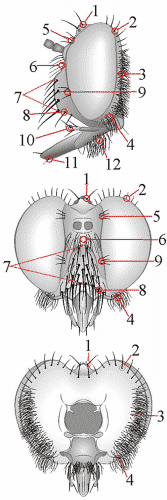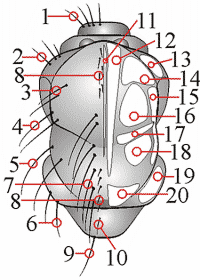|
Head

Fig. 1: chaetotaxy, head
|
|
|
Fig. 1:
|
|
1 = |
ocellar bristles and postocellar bristles, oc b + poc b [1]
|
|
2 = |
postocular bristles, pocl b [1]; occipital bristles [2]
|
|
3 = |
occipital bristles/hairs, ocp b / h [1]; occipital bristles; hair on the back of the head; postcranial hairs [-]
|
|
4 = |
lower occipital bristles/hairs, gn b / h; cheek hairs [1]; post-genal beard [-]; genal hairs
|
|
5 = |
orbital bristles/hairs, pc orb b [1]; above antennal sockets: frontal hairs/bristles
|
|
6 = |
facial bristles/hairs, fc b / h [-]
|
|
7 = |
mystax [1/2/8]; face beard [2]
|
|
8 = |
subvibrissal bristles/hairs ?, sbvb b / h; peristomal hairs; oral bristles [1]; epistomal bristles [2]; lower marginal bristles [8]
|
|
9 = |
parafacial bristles/hairs, pafc b / h [1]
|
|
10 = |
palpal bristles/hairs, plp b / h [1]
|
|
11 = |
labial bristles/hairs [-]
|
|
12 = |
proboscial bristles/hairs [-]; labial hiars
|
|
Thorax

Fig. 3: chaetotaxy, thorax - dorsal
|
|
|
Fig. 3:
|
|
1 = |
antepronotal bristles, aprn b [-]; pronotal bristles [2]; collar bristles [3]
|
|
2 = |
postpronotal bristles, pprn b [1]; humeral bristles [2]; humeral bristles [1/5]
|
|
3 = |
posthumeral bristles [2]; posthumeral bristles [5]
|
|
4 = |
notopleural bristles, npl b [1/2]; notopleural bristles [3/5]; presutural bristles [Cannings, 2002]
|
|
5 = |
supraalar bristles, spal b [1/2]; intraalar bristles [3/5]
|
|
6 = |
postalar bristles, pal b [1/2]; posterior bristles [3/5]
|
|
7 = |
dorsocentral bristles, dc b [1/2/4]; dorsocentral bristles [3/5]
|
|
8 = |
acrostichal bristles, acr b [1/2/4]; acrostichal bristles [5]
|
|
9 = |
marginal scutellar bristles, sctl b [1/2]; scutellar bristles [3/5]
|
|
10 = |
discal scutellar bristles, ds sctl b [1]; discoscutellar bristles [3]
|
|
11 = |
median stripe of scutum [-]; median stripe [#]; medial stipe [Cannings, 2002]
|
|
12 = |
paramedian stripe of scutum [-]; central stripe of mesonotum [3]; paramedian stripe [4]; acrostichal stripe and sometimes an additional dorsocentral stripe [Cannings, 2002]
|
|
13 = |
humeral spot [-]
|
|
14 = |
posthumeral spot [-]; posthumeral tomentose area [4]
|
|
15 = |
lateroscutal stripe [-]; marginal tomentose area [4]
|
|
16 = |
presutural spot [-]; presutural lateral spot [3]
|
|
17 = |
sutural spot [-]; sutural tomentose area [4]
|
|
18 = |
postsutural spot [-]; postsutural lateral spot [3]
|
|
14-18 = |
intermediate spots [Cannings, 2002]
|
|
19 = |
postalar spot [-]
|
|
20 = |
prescutellar spot [-]
|
|

Fig. 4: chaetotaxy, thorax - lateral
|
|
|
Fig. 4:
|
|
1 = |
anterior antepronotal bristles; pronotal bristles [2]; collar bristles [3]
|
|
2 = |
posterior antepronotal bristles [-]
|
|
3 = |
proepisternal bristles, prepst b [1]
|
|
4 = |
coxal bristles [-]
|
|
5 = |
coxal bristles [-]
|
|
6 = |
coxal bristles [-]
|
|
7 = |
(dorsal) anepisternal bristles, anepst b [1]
|
|
8 = |
anterior basalare bristles [-]
|
|
9 = |
(posterior) anepisternal bristles, anepst b [1]
|
|
10 = |
anepimeral bristles [-]
|
|
11 = |
metepisternal bristles [-]
|
|
12 = |
katatergal bristles [-]; postnotal fan [2]; [-]
|
|
13 = |
anatergal hairs [-]; hairs on postnotal callus [2]
|
|
14 = |
lateral marginal bristles, l m b [1] - remark: not congruent in the figure; bristles on posterolateral corners [8]; discal bristles [2]; macrochaetae on sides of tergites [7]; latero-discal bristles; lateral bristles on tergites at posterior corners [-]
|
|
Abdomen

Fig. 7: chaetotaxy, abdomen
|
|
|
Fig. 7:
|
|
1 = |
lateral marginal bristles, lms [1] - remark: not congruent in the figure; bristles on posterolateral corners [8]; discal bristles [2]; macrochaetae on sides of tergites [7]; latero-discal bristles; lateral bristles on tergites at posterior corners [-]
|
|
2 = |
spines (on the acanthophorites) [1/7]
|
|
|
bristle = |
a stiff hair, usually short and blunt [5]
|
|
chaeta = |
(pl. chaetae). a joined outgrowth of the skin, originating in a cup-like pit at the end of a pore canal, essentially an elongated epidermal cell [5]
|
|
hair = |
a slender flexible filament of equal diameter throughout [5]
|
|
macrochaeta = |
(pl. macrochaetae). the long bristles occurring singly on the body of Diptera [5]
|
|
macrotrichia = |
in Diptera the larger microscopic hairs on the surface of the wings [5]; single or branched hairs, sometimes called setae; these are hollow, longer than microtrichia, and arise from a pit or socket; they may be fine or thickened [6]
|
|
microchaeta = |
(pl. microchaetae). small bristles, as opposed to macrochaeta [5]
|
|
microtrichia = |
minute, hair-like structures found on the wings of certain insects; they resembles small covering hairs, but the absence of basal articulation distinguishes them; fixed hairs; aculei [5]; minute non-movable hairs formed from cuticle; may produce an impression of cloudiness or colour [6]
|
|
pile = |
a hairy or fur-like covering; thick, fine, short, erect hair, giving a surface appearance like velvet [5]
|
|
pruinescence = |
a minute dust or bloom covering certain insects [5]
|
|
pubescence = |
downy; clothed with soft, short, fine, closely set hair [5]
|
|
scale = |
a flat unicelluar outgrowth of the body-wall, of various shapes and probably a modified seta [5]; modified hairs or setae; they are flattened and coloured but otherwise essentially similar to setae in their structure [6]
|
|
seta = |
(pl. setae). macrotrichia; commonly known as hairs; hollow structures developed as extensions of the epidermal layer; slender, hair-like appendages [5]
|
|
setula = |
(pl. setulae). a small stiff bristle or seta; in Diptera, the small spine ["thorn" in the original text] at the end of the subcosta [5]
|
|
spine = |
a multicellular more or less thorn-like process or outgrowth of the cuticula not separated from it by a joint - or: a large seta provided with a calyx or cup by which it is articulated to the cuticula [5]; non-movable hairs formed from cuticle, thicker and stronger than microtrichia [6]
|
|
spinula = |
(pl. spinulae). a small spine; one of the spinous processes at the apex of the tibia, also called spines, spurs or heels; a hair-like appendage of the cuticula [5]
|
|
spur = |
a spine-like appendage of the cuticula, connected to the body-wall by a joint [5]; thick cuticular hairs or spines on the legs of certain insects [6]
|
|
tomentum = |
a form of pubescence composed of matted, wooly hair; in Diptera applied to a covering of short, flattened, more or less recumbent, scale-like hair which merges gradually into dust or pollen [5]
|
|
References
[1] McAlpine, J.F. (1981): Morphology and terminology - Adults. - In: McAlpine, J.P. et al. (eds.): Manuel of Nearctic Diptera, vol. 1; p. 9-63 - Ottawa: Research Branch, Agriculture Canada, Monograph 27.
[2] Theodor, O. (1980): Fauna Palaestina - Insecta II - Diptera: Asilidae; 446 pp. - Jerusalem: The Israel Academy of Science and Humantities.
[3] Artigas, J.N. (1967): The Asilidae (Diptera) of Chile, 2 Vols. - Xerography of Doctoral Diss., University Microfilms: 674 pp.; Ann Arbor.
[4] Fisher, E. (1986): A reclassification of the robber fly tribe Andrenosomini, with a revision of the genus Dasyllis Loew (Diptera: Asilidae); 361 pp. - Riverside: Ph.D. thesis, University of California.
[5] Torre-Bueno, J.R. de la (1985): A Glossary of Entomology (6th printing); 336 pp. + 9 pls. + 36 pp. (Suppl.). - New York Entomological Society.
[6] Leftwich, A.W. (1977): A Dictionary of Entomology; 360 pp. - London: Constable.
[7] Hull, F.M. (1962): Robber flies of the world, 2 volumes; 907 pp. - Washington: Bulletin of the United States National Museum 224 (1,2).
[8] Wood, G.C. (1981): Asilidae. - In: McAlpine, J.P. et al. (eds.): Manuel of Nearctic Diptera, vol. 1; p. 549-573 - Ottawa: Research Branch, Agriculture Canada, Monograph 27.
|